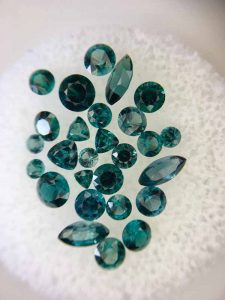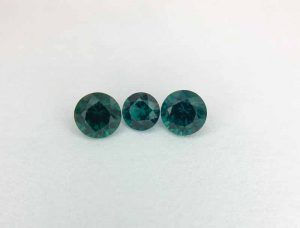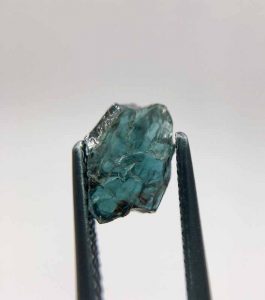Something blue

In the last five years, a surprising amount of interesting new gem varieties have arrived on the scene, including grape botryoidal agates from Indonesia, ammonite negatives with pyrite (mostly from Russia), aquaprase quartz from Africa, and much more. So, when a supplier came to me with a new variety of gemstone in June 2017, I was already waiting for something great. I didn’t know I would be getting something amazing!
I bought some roughs of the new gem, which my supplier claimed was a blue variety of garnet. There was no proof the stone was what he said it was—the purchase was all based on trust. However, I knew the Gemological Institute of America (GIA) was also getting a sample.
In November of that year, the institute confirmed the stone to be blue-green pyrope-spessartine garnet with high vanadium or, in simpler terms, the first blue garnet by GIA definition.
Every gemmology schoolbook will tell you garnet does not exist in this particular colour, except in the form of a colour-change garnet, in which case blue is not the primary hue. (It’s more of a bluish-green in sunlight, and a violet-red when lit by light-emitting diode [LED].) To quote GIA:
“Unlike traditional blue-green garnets that exhibit a color change from purplish or orange red in incandescent light to bluish or yellowish green in daylight, these essentially remained blue in the lighting conditions we tested (CIE standard illuminants D65, A, F10, and F9, and a cool LED light with a 7500K color temperature). They showed only a weak color change from violet or blue in incandescent light … to green or blue-green in daylight.“
Blue garnet’s colour is caused mainly by the element vanadium. Normally, in a pyrope-spessartite colour-change garnet, the colours come from vanadium and manganese, but to this author’s knowledge, this new type has a higher dose of vanadium than ever previously seen. The first deposit (and the only one, as far as we know) is at the border of Tanzania and Kenya.

Why is this a big discovery?
The discovery of blue garnet proves nothing is impossible—if a gemstone doesn’t exist in a certain colour, maybe it just has not been found yet. What’s more, this gem brings a new type of blue to the market! Its dark and saturated greenish-blue is a new option that differs from sapphire, indicolite tourmaline, tanzanite (which is more violet-blue), spinel (more teal-blue), topaz (sky blue, Swiss blue, and London blue), zircon (turquoise-blue), and aquamarine.
With a hardness of 7 on the Mohs scale, this gem is perfect for any kind of jewellery and offers a new birthstone colour choice for January babies. (For more, consult the Practical Gemmology Handbook, published by the Gemmological Association and Gem Testing Laboratory of Great Britain [Gem-A] in 2012.) A few faceted specimens have been released on the market, although big roughs (larger than two carats) are rare to nonexistent at the moment. Gemmologists, laboratories, and jewellers alike have jumped at the opportunity to buy this blue gem, and finding the material has become difficult.
Rough deal
Buying blue garnet is also a challenging task because the Tanzanian government has been changing the laws in the country to benefit the economy—a good thing for Tanzania, but not so much for outside buyers. The selling of rough gemstones has become complicated, as most of the rough has to be cut in the country before it is exported elsewhere, completely changing the prices and market.

In Tanzania, smaller roughs (those under a carat) are almost never cut inside the country. Therefore, with new laws forbidding the sale of facet rough outside Tanzania, it has become difficult for smaller rough to be sold for cutting. Tanzanian cutters are well known for cutting bigger-sized gems, unlike those in India, for example, who are known to be good with smaller rough and gems.
Blue garnet is one of the gems found in small sizes, and is therefore difficult to get out of Tanzania now. Much of the industry is expecting (but hoping against) a rise in prices for all gemstones from Tanzania, including spinels, garnets, tanzanites, and tourmalines, if the laws don’t change again soon. Suppliers in the country are having a hard time meeting demand for gems because of this.
Let us hope the blue garnet will stay with us and be a new gem colour we can add to our jewellery collections.





